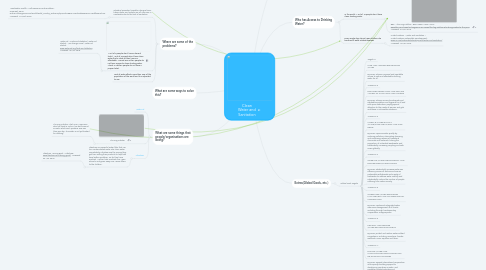
1. Where are some of the problems?
1.1. Intestinal parasites, hepatitis, dengue fever, tuberculosis, and malaria are all common in Cambodia due to the lack of sanitation.
1.1.1. "Cambodia: Health." CultureGrams Online Edition, ProQuest, 2018, online.culturegrams.com/world/world_country_sections.php?cid=28&cn=Cambodia&sname=Health&snid=22. Accessed 14 March 2018.
1.2. 1 out of 3 people don't have a decent toilet. 1 out of 9 people don't have clean water that is close to their home or affordable. Around 844 million people do not have access to clean drinking water. About 2.3 billion people do not have a proper toilet.
1.2.1. WaterAid. "Facts and Statistics | WaterAid Global." We Change Lives | WaterAid Global, www.wateraid.org/facts-and-statistics. Accessed 16 Mar. 2018.
1.3. Lack of water affects more than 40% of the population of the world and it is expected to rise.
2. What are some ways to solve this?
3. What are some things that people/organisations are doing?
3.1. WaterAid
3.2. The Fog Catcher
3.2.1. The Fog Catcher, Abel Cruz, a Peruvian who has lived in a slum, has built around 60 nets, which each produce 200-400 litres per day. The water is not yet treated for drinking.
3.3. LifeStraw
3.3.1. LifeStraw is a powerful water filter that can turn contaminated water into clean water immediately, LifeStraw use the money they get from selling their products to help kids have better sanitation. So far they have reached 1 million kids, reached over 1500 schools, and given away over 10500 filters to the children.
3.3.1.1. LifeStraw. "Giving Back." LifeStraw, www.lifestraw.com/doing-good/. Accessed 22 Mar. 2018.
4. Who has Access to Drinking Water?
4.1. In the world, 1 out of 10 people don't have clean drinking water.
4.1.1. BBC. "The Fog Catcher." BBC News, 2 Dec. 2016, www.bbc.com/news/av/magazine-38175202/the-fog-catcher-who-brings-water-to-the-poor. Accessed 15 Mar. 2018.
4.2. Every single day, almost 1000 children die because of water related diseases
4.2.1. United Nations. "Water and Sanitation." United Nations Sustainable Development, www.un.org/sustainabledevelopment/water-and-sanitation/. Accessed 16 Mar. 2018.
5. What is Water and Sanitation?
6. Extras(Global Goals, etc.)
6.1. Global Goal Targets
6.1.1. Target 6.1
6.1.2. SAFE AND AFFORDABLE DRINKING WATER
6.1.3. By 2030, achieve universal and equitable access to safe and affordable drinking water for all.
6.1.4. TARGET 6.2
6.1.5. END OPEN DEFECATION AND PROVIDE ACCESS TO SANITATION AND HYGIENE
6.1.6. By 2030, achieve access to adequate and equitable sanitation and hygiene for all and end open defecation, paying special attention to the needs of women and girls and those in vulnerable situations.
6.1.7. TARGET 6.3
6.1.8. IMPROVE WATER QUALITY, WASTEWATER TREATMENT AND SAFE REUSE
6.1.9. By 2030, improve water quality by reducing pollution, eliminating dumping and minimizing release of hazardous chemicals and materials, halving the proportion of untreated wastewater and substantially increasing recycling and safe reuse globally.
6.1.10. TARGET 6.4
6.1.11. INCREASE WATER-USE EFFICIENCY AND ENSURE FRESHWATER SUPPLIES
6.1.12. By 2030, substantially increase water-use efficiency across all sectors and ensure sustainable withdrawals and supply of freshwater to address water scarcity and substantially reduce the number of people suffering from water scarcity.
6.1.13. TARGET 6.5
6.1.14. INTEGRATED WATER RESOURCES MANAGEMENT AND TRANSBOUNDARY COOPERATION
6.1.15. By 2030, implement integrated water resources management at all levels, including through transboundary cooperation as appropriate.
6.1.16. TARGET 6.6
6.1.17. PROTECT AND RESTORE WATER-RELATED ECOSYSTEMS
6.1.18. By 2020, protect and restore water-related ecosystems, including mountains, forests, wetlands, rivers, aquifers and lakes.
6.1.19. TARGET 6.A
6.1.20. EXPAND WATER-AND SANITATION-RELATED SUPPORT FOR DEVELOPING COUNTRIES
6.1.21. By 2030, expand international cooperation and capacity-building support to developing countries in water- and sanitation-related activities and programmes, including water harvesting, desalination, water efficiency, wastewater treatment, recycling and reuse technologies.
6.1.22. TARGET 6.B
6.1.23. SUPPORT LOCAL ENGAGEMENT IN WATER AND SANITATION MANAGEMENT
6.1.24. Support and strengthen the participation of local communities in improving water and sanitation management.

